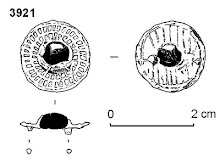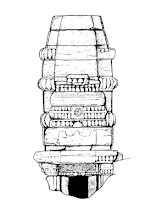For many years context sheets and registers have been written on paper, whilst the databases containing the context information have been held on computer. Many early context sheets were designed for computer entry, and the standardised format, definitions and controlled vocabulary of a processual recording system lends itself perfectly to computer entry. The level of actual computer entry of context data varies massively across the country, with some units inputting all context data, whilst others select certain key details, and most of this data entry takes place off-site and in post-ex.
On site the paper record remains practically universal despite the rise of electronic recording in other aspects of site work and the pronouncement and subsequent expectation that we would 'go digital' sooner rather than later. Still, even when English Heritage trialled Intrasis, an electronic GIS based recording system, they used paper forms on-site, followed by data entry in the dry of the cabins (it was trialled in Cumbria in October!).
 |
| The work environment: an urban site may not have as much mud as some rural sites, but its still a tough environment and the i-Pads coped well. |
The difficulties of using computer data-entry on site appear to be many and appear to be obvious: equipment costs, mud, rain, battery life, mud, rain, internet signal, IT support issues and the fact that you need to be able to do sketches on the back of the context sheet. Several projects have however successfully used electronic data-loggers in adverse conditions, including all the human bone assessment data for the Spitalfields project which was inputted into hand-held dataloggers despite conditions of high humidity in the on-site processing area. With the increased use of digital cameras and GPS we are now used to looking after electronic equipment on site, and dealing with all the issues of rain, mud, damp and battery charging.
Although context sheets may be with us for some years yet, there is one facet of site recording that can be very simply transferred to electronic data-logger: the site registers. Despite a reputation as a bit of a Luddite I have felt we should adopt digital registers for some years, and recently I had a second chance to try them out again whilst working with LP Archaeology on an urban evaluation in London. The recording system was the standard urban single-context system, but with one minor tweek: all the registers were inputted direct into i-Pads linked via wi-fi to an online Ark database. All the registers were entered straight into the database: context register, plan register, section register and enviro sample register. Photographic registers were also entered online. Two i-Pads were used, one by each team.
i-Pads aren't cheap, however we were using them on site anyway for email and admin, so there was no extra cost. We could have used a laptop, notepad or even a smart-phone. The i-Pads were kept in ruggedised cases (like you get for smart-phones) which kept them dry and working well despite a lot of breaker dust and some mud and rain. We obviously looked after the i-Pads and tried to keep them clean, but no more care was needed than for a digital or manual camera. Battery life was good, although we did have electricity on-site, but even if you have no generator a simple power inverter can charge an appliance from a van.
One difficulty was that internet signal could be temperamental, especially several metres down a shaft, however the i-Pads did function well, even inside concrete buildings; in an open-field situation the i-Pads should function as well as any 3G based internet signal (compare with GPS working on poor mobile signals). Each i-Pad could be used simultaneously, although there were issues if two colleagues saved a record at exactly the same moment, backing up registers was done automatically. Our system could not work off-line, however it is very simple to create a system that works off pre-allocated number sequences and is uploaded daily to the master database.
The integral camera is not good enough for detailed record shots, however it was used to take non-archive progress shots, and these could be registered immediately and tagged; ideally one could link a photo from a digital camera via Bluetooth and tag that image via the database.
.PNG) |
| Screenshot of context register screen on Ark database |
.PNG) |
| Screenshot of context register in Ark database showing drop down list for context type, other fields are for free text allowing flexibilty where it is needed. |
As the data is entered direct into the database the records can be instantly linked to a GIS project and interrogated, especially if plans are digitised on-site or GPS is used. You can then look at sample locations, distribution of particular spot dates, and even the number of contexts dug by a particular excavator…
Is this the future of recording? Well it seems to work within an urban context with a mix of techno-savvy Diggers, and one die-hard Luddite. We already keep expensive kit dry and mud-free, and with ruggedised cases there is less danger of damage –after all, paper is often unworkable when wet. Whether digital registers could pass the slime-test of a Wealden clay site in February is yet to be seen, cheaper data-loggers can be used instead of i-Pads, and better applications to link digital photos to the databases can be written, but as far as this Luddite is concerned electronic recording is
part of the future, albeit with the usual caveats!
Many thanks to Guy Hunt of LP Archaeology for permission to use the images in this article. This article was originally published in the Diggers' Forum newsletter issue 10.














No comments:
Post a Comment